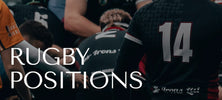
Rugby Positions
, by Becca McPartland , 5 min reading time

, by Becca McPartland , 5 min reading time
Before the first whistle of a rugby game, when the whole team is lined up together, it becomes apparent that a rugby squad is formed of many shapes, sizes and builds. Rugby is unique in that each position requires a particular set of physical and technical attributes, which is what makes the game so popular and open to all.
Let’s take a closer look at some of the 15 positions played in rugby!

The forward positions consist of the first eight players in a team. The primary responsibility of the forwards is to make up the scrum. They tend to have large, strong builds to be able to push the opposition’s scrum pack, as well as run through tackles and prevent the other team’s forwards from gaining territory.
As previously mentioned, the forward positions make up the scrum pack. These are; a hooker, two props, two locks (second rows), two flankers and the number eight. Each of these positions has different roles within the scrum:
Front Row
The front row is made up of the hooker and two props. After the ball is placed into the scrum by the scrum-half, the hooker “hooks” the ball backwards, aiming for the ball to land at the feet of the number eight. The two props help support the weight of the hooker so they can effectively hook the ball and bind the player to the rest of the scrum pack.
Second Row
Made up of two locks, the second row connects the front and back rows and anchors the scrum pack. Plus, the second row can assist with pushing.
Back Row
On the back row are two flankers and the number eight. These players are responsible for most of the pushing as they are able to set themselves more steadily from the back. The number eight tends to keep the scrum balanced, whereas the two flankers can peel off when the ball is back in open play.

The main responsibility of the full-back is tackling opposition players who have broken through the defensive line, preventing them from scoring.
Another key role for full-backs is providing support for ball runners. As in, when a player makes a break and runs into the open field, the full-back should run alongside them to provide an easy pass and prevent tackles from opposing players. These differing roles mean full-backs need a combination of strength and speed to be effective in their position.

The fly-half acts as the primary decision-maker for the team. They decide whether to kick, run or pass the ball. Fly-halves tend to be fed the ball by the scrum-half. They then base their decision-making on factors such as the speed of the ball, their position on the pitch and the current game situation. These decisions ultimately shape the play style and chances of a win.
Every team starts a match with a hooker on the pitch and a replacement on the bench. Hookers, of course, have a specialist role within the scrum as we learnt earlier, but they also have a key role in the lineout. Hookers are responsible for throwing the ball down the middle of the two rows of forwards.
Hookers need to be very strong for their role, but they tend to be shorter and lighter than their neighbouring props on the front row.
Hopefully, you’ve learned a thing or two about rugby positions and their responsibilities. At Absolute Rugby, we live and breathe the game, so be sure to keep up with all the latest from us by visiting our blog.
We also provide an excellent selection of rugby boots, training essentials, rugby clothing and much more. Visit our website to browse the full range.


